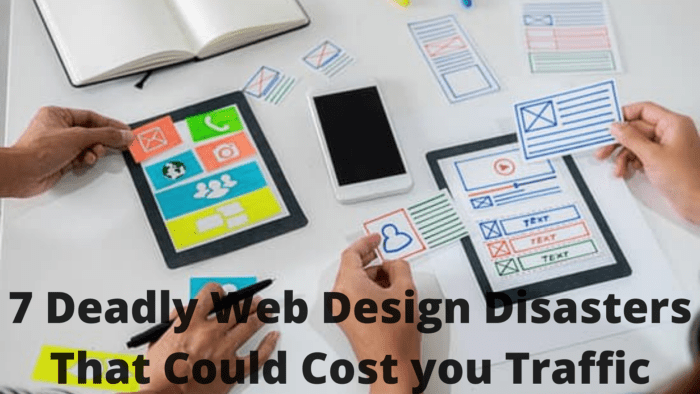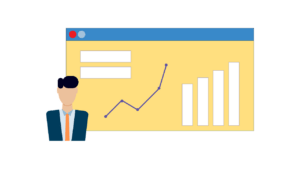7 Deadly Web Design Disasters That Could Cost you Traffic

Most business owners are aware that they cannot afford to have a poorly designed website. Your website essentially serves as your calling card and provides a wealth of information to potential customers. The popularity of custom web development services can be attributed to this. Simply put, having a website isn’t enough; you need one that distinguishes your business from the competition.
On the other hand, you could be setting yourself up for failure if you try to stand out too much or ignore website design fundamentals.
While some web design errors kill conversions, others have a negative effect on a website’s success. If nothing is done to correct them, they will guarantee that your website’s prospects will decline and that online traffic will cease altogether.
Let’s examine these errors more closely in order to understand them better and prevent them. Note that there is no apparent order of relevance for the points stated in the list below.
1. Social Media Unfriendliness
Is there a blog on your website? Are there social sharing buttons on your website’s pages? If the answers to these questions are “no,” there is a good chance that this is the cause of your website’s low traffic or low conversion rates.
The design of your website must be social media friendly, which means you must ensure that users can easily share the content there with their friends and followers on social media. This implies that you must include social media experiences into your website in various ways. The interaction and engagement level of your website will increase as a result, increasing website traffic and enhancing conversion rates.
There is no requirement that it always be a live feed. All that’s required from you is to add a few social network icons on the page that link to your handles to allow visitors to navigate to them whenever they want. Also, these icons should take up a portion of every page. This increases the user’s familiarity with your brand and may encourage conversion via a different channel.
2. Poor compatibility for mobile users
Most people these days use their phones to search the internet. Buying via mobile devices rather than laptops or desktop PCs is also gaining popularity. Your website needs to be mobile-optimized if you want to reach these clients. Potential clients will become disappointed by a poorly optimized website (one that is challenging to use on the phone or read).
For not being mobile-optimized, Google may potentially punish you. You can’t take that chance because users of smartphones and tablets should make up a large portion of your traffic. Making sure your website is mobile-compatible should be a top priority, given that mobile devices now generate the majority of internet traffic. If not, you risk losing out on the potential of your website.
3. Slow website loading time
Whatever web design services you choose, be sure you recognize the value of quick website loading time. Your website’s pages must all load wholly and swiftly. Google is known to punish websites that take too long to load, which means that your company won’t appear in pertinent searches.
In other words, people won’t hang around for your website. In fact, if a web page takes longer than three seconds to load, 40% of visitors will leave. You won’t just drive away potential consumers; Google might even take action to ensure no one else can find you.
4. Too Many Fonts
It can feel like playing a memory game to select the perfect font for a website. There are several options, but only a few fonts seem suitable for your website. Your website’s usability may suffer if you choose the wrong fonts. The goal of your website is to make it simple for potential customers to utilize; therefore, you don’t want it to happen.
How should you choose the most pleasing fonts for websites? No more than two font families should be used on a single website. A font family may contain different weights of the same font, giving you more options without creating confusion or clutter.Impress your visitors with the elegant simplicity of your well-considered font selections.
Visitors leave and never return if your website looks too busy and gaudy. They will find it easier to read the website elsewhere because it is more convenient to read another website. By staying on your website to read more about you and to get to know you better, your users will appreciate the simplicity of your website design and content, which will start a great relationship with you.
5. Poor Navigation on your website
One-click navigation from point A to point B is desirable for anyone visiting a website. The navigation on a website depends significantly on its design. There should be all possible ways to access any website in a navigation window. Every website page should have this option so that moving from one section to another doesn’t require additional clicks.
As a result, your website will be easier for visitors to navigate and will need fewer updates. The likelihood of a person staying on your website for longer is therefore increased. You gain more conversions as a result, which also benefits your SEO.
You will lose traffic and worthwhile new users if you make any of these mistakes. Hence, keep in mind to create a design that is as user-friendly and uncluttered as feasible.
6. Flair over function
Naturally, you want your website to look great. Nevertheless, keep in mind that it must also have a purpose. You forget that customers are looking for information on your website when you sacrifice content for aesthetics.
To prioritize aesthetics more than functionality or vice versa is a mistake that must be avoided. The visual design and general desired appeal of your website are considered part of its aesthetics. The usability, however, is related to the many features and functions. For a website to succeed online, it must have outstanding aesthetic and functional qualities, much like a machine with an equal number of cogs that requires equal maintenance to function well.
Although it should appear suitable, your website shouldn’t solely focus on aesthetics. It must be beneficial above anything else. You’ll see a decline in traffic if it isn’t. Other than a visually appealing page, you must offer visitors something. If a site is hard to use or doesn’t have what users need, they will go elsewhere.
7. Not Answering Users’ Questions
On the web, visitors are very goal-oriented. They go to websites because they have a goal in mind, perhaps even to purchase your product. A website’s inability to deliver the information people seek is the ultimate failure.
If you don’t provide visitors with the information, people will presume that your product or service will not satisfy their needs. Occasionally, the answer is simply not there, and you lose the sale. Other times, the details are hidden beneath heavy layers of marketing speak and bland slogans. Such buried information might as well not be there, as consumers don’t have time to read everything.
The worst example of not providing the information is avoiding listing the price of products and services, despite knowing that cost is essential since it enables customers to compare products and click through to the most relevant ones. Customers use price as the most particular piece of information to determine an offering’s nature, so failing to provide this information causes confusion and decreases customer knowledge of a product line.
To Conclude
Committing these errors may decrease your traffic and discourage valuable new users. Most of them seem common sense, but they all get broken more frequently than you think. So remember to make your design as user-friendly and uncluttered as possible. Avoid these seven deadly mistakes, and you will be well on your way to building a website that gets a lot of traffic and has a high conversion rate.







